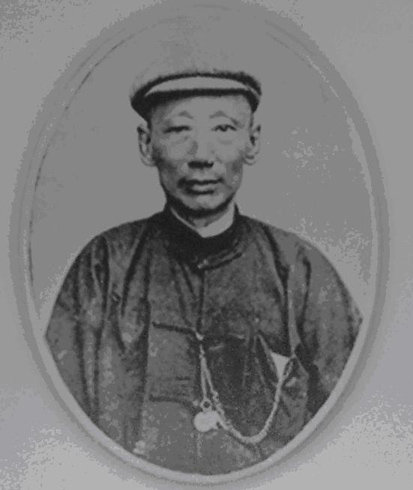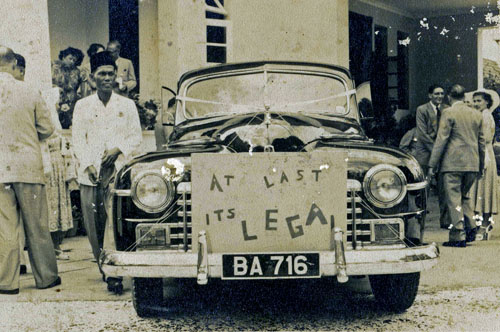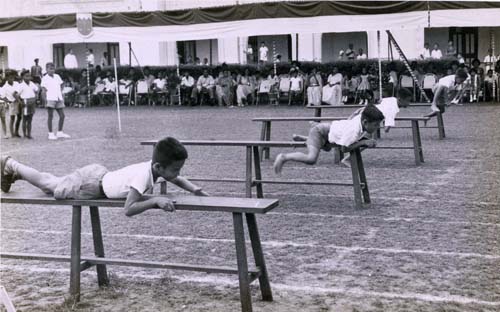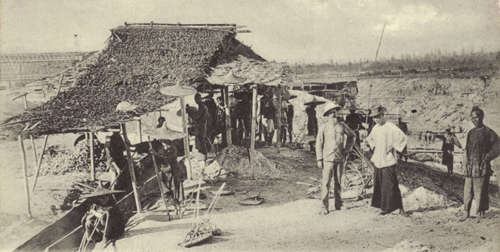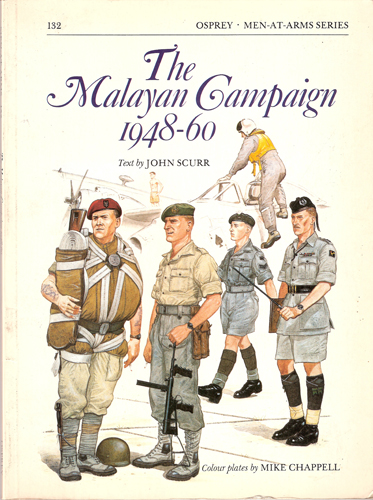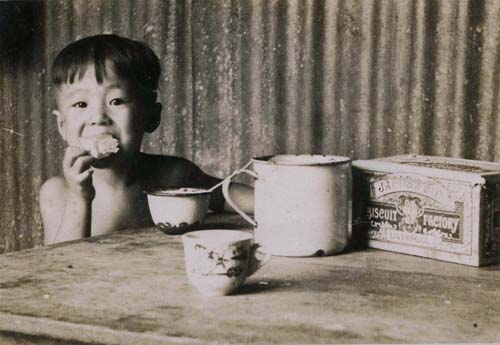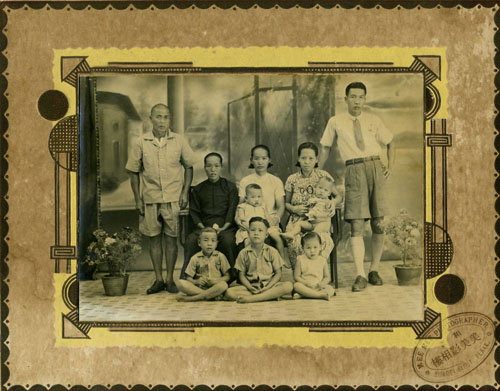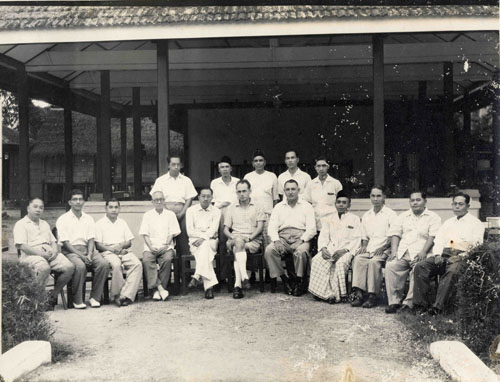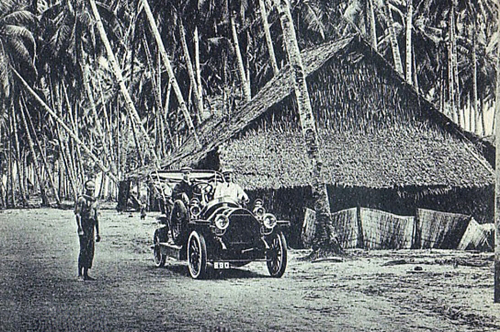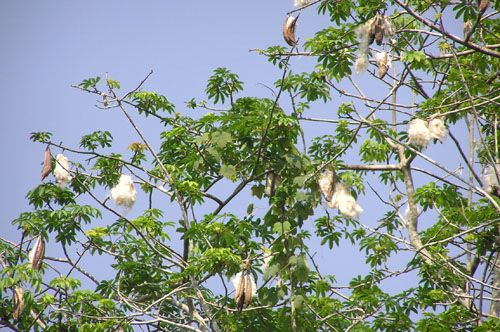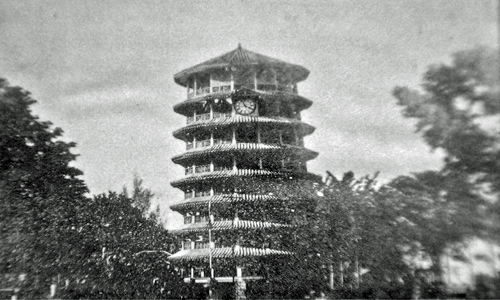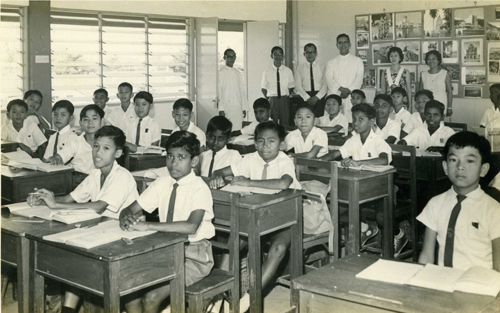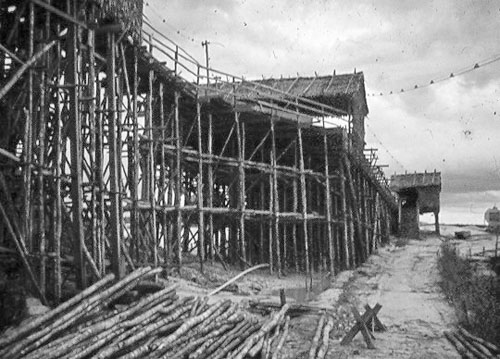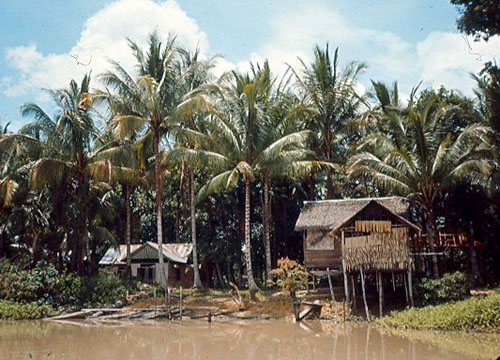October 2009
At Last it’s Legal, but Where was it?
This old picture turned up in Kampar amidst a whole lot of other local photographs originally belonging to a friend’s father. Of course it is not a Perak registration and may not even be in Perak, but being the eternal optimists we are posting it in case it is recognised.
The guests seem to be mainly European although there could be some Chinese on the left. The simple ribbon decoration on the car is also very typical of the British. The Syce is of course very smartly turned out for the occasion.
We look forward to your comments.
A Great Kaulfuss Photo – “Chinese Washing Tin in Perak”
This photograph was one of literally hundreds that the famous German photographer took around 1900. August Kaulfuss was born and educated in Rohnstock, Silesia. He served in the German Navy for a couple of years then worked in the photographic studio of Otto van Bosch in Frankfurt. He arrived in Penang in 1883 and soon established a photographic firm at 9 Farquhar Street.
He travelled widely, mostly on foot, across almost all of the Malay Peninsula, from Province Wellesley in the north to Johore in the south as there were almost no roads or railways. Many of his photographs were made into picture postcards, a range of which are on the ipohWorld main site’s database. It is believed he returned to Germany before the First World War.
Croc, the Menace
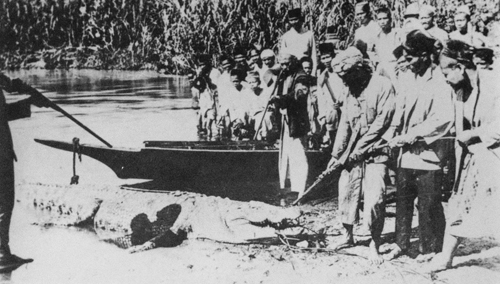 This photo shows a crocodile that was shot in the Kinta River which runs through Ipoh Town. The hunter was an European (referring to the hunter’s attire ) who helped the villagers to put an end to this crocodile’s menace. And the villagers were so excited to see the dead gigantic croc. We will be happy to hear from you, if you have information regarding this picture.
This photo shows a crocodile that was shot in the Kinta River which runs through Ipoh Town. The hunter was an European (referring to the hunter’s attire ) who helped the villagers to put an end to this crocodile’s menace. And the villagers were so excited to see the dead gigantic croc. We will be happy to hear from you, if you have information regarding this picture.
The Curse of Ipoh Town
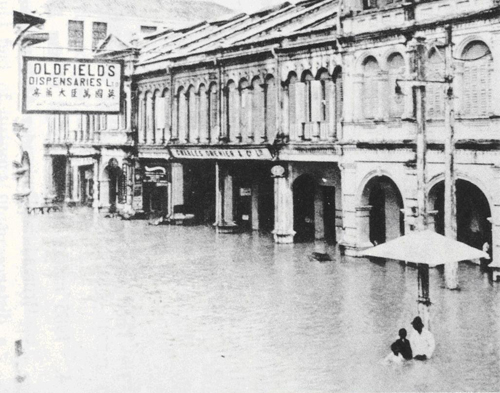 This picture shows one of the worst floods that ever happened in Ipoh. It was in 1926 and the picture was taken at the corner of Belfield Street and Station Road.
This picture shows one of the worst floods that ever happened in Ipoh. It was in 1926 and the picture was taken at the corner of Belfield Street and Station Road.
The precautions against such a disaster was taken earlier than this date. Around 1914-1921, the Ipoh Flood Mitigation Scheme had been carried out to protect the town from the then regular flooding. The aims of the scheme were to eliminate the sharp bends in the Kinta’s course through Ipoh Town; to divert waters of Sungei Choh into Sungei Pinji, instead of flowing directly into the Kinta above Ipoh. But the scheme wasn’t good enough to prevent the flood from continually trying to destroy Ipoh.
Thankfully further more effective measures were taken and we no longer suffer the curse of Ipoh Town.
The Malayan Campaign – A Useful Reference Book
Although not a new publication (it was first published in 1982 and reprinted in 1984) it is out of print but sometimes still available on the Internet. It forms a very handy introduction to the Malayan Emergency of 1948 to 1960. Ideal for the student or as a first-time introduction to the events of those difficult times.
Osprey describe it thus:
In June 1948 Communist insurgent forces commenced a guerrilla war to end British rule in Malaya. During the ensuing 12 years of conflict there were 8750 reported ‘contacts’ between units of the Security Forces and the Communist enemy. Eventually Malaya was made independent, and the British and their Commonwealth allies emerged victorious. Written and illustrated by infantry veterans of the campaign, this book examines the Malayan Emergency, detailing the forces involved and the harsh jungle conditions in which they fought. The text is complete with firsthand accounts from the contributors themselves and numerous illustrations depicting the forces’ uniforms.
For the enthusiast it is worth searching for and rumour has it that it is to be reprinted. Keep an eye out in the bookstores if you are interested.
“Jacobs & Me”
Remember the days when those Jacobs biscuits came in tins? Not forgetting those enamel bowls/mugs/tiffin-carriers too.
We are sure some of you out there might have fond memories and maybe even (still) own these enamel ware or Jacobs biscuit tins.
Deepavali Greetings

On this auspicious day
We take this opportunity to wish all our Hindu Readers
Happy Diwali
May the forthcoming year
bring light into all your lives
From the staff of ipohWorld.
Perak Heritage Society Illustrated Talk 23rd October 2009
B M Iversen: the Danish Architect of Ipoh
an illustrated talk by
Ruth Iversen Rollitt
Royal Ipoh Club
Friday, 23 October 2009
5:30 – 7:00 pm
Registration and refreshments begins at 5 pm
Admission by donation only
PHS members RM10, non-members RM15
Born in Copenhagen, Denmark in 1906, BM Iversen arrived in Malaya in 1928 and worked for two architectural firms before setting up his own practice in Ipoh in 1936. After World War II, Iversen, van Sitteren & Partners had offices in Ipoh, Penang, Kuala Lumpur and Singapore. Notable buildings he designed in Ipoh include the Cathay Cinema and the Geosains Complex. His signature International Style won him many private and public commissions. According to Ken Yeang’s book Architecture of Malaysia, “It became an indication of status among Ipoh’s wealthy businessmen to own an Iversen-designed house.”
Perak Heritage Society
Contact: Law Siak Hong 017-506-1875
Any Good at Guessing Games?
Here is a nice old picture of a Sungai Siput family, taken and framed by Mee Mee Photographer & Frame Makers. It came from a friend in Tanjung Rambutan but like us he knows nothing about it. Do you know anything or would you like to hazard a guess as to the name of the family or the date the photograph was taken? Any help would be gratefully received.
District Officer and the Kampung Committee
This picture was taken by New Good Friend Studio & Frame Makers, of No.7 Theatre Street, Ipoh. It is believed to show the British District Officer wearing shorts in the centre, with a visiting Government Officer and the Village Council Members.
Behind the group there appears to be an open building with a tiled roof, and on the left an attap roof kampung house. Could this be the opening of the new communal building for use of the people in the village?
If anybody has any clues about the origins of this photograph, said to be in the Kampar District, we will be very pleased to hear from you.
The “Haves” and “Have-Nots” of 1908
Here we have an old photograph said to be Tin Miners out for a spin in their new motor car. Clearly they were the “Haves” of Malaya at the time, but surely it was a pretty tasteless thing to do – driving into a Kampong to display your wealth to the natives. Not to mention filling their clean air with petrol fumes.
But don’t get excited for we believe this was a deliberately posed photo to be put on a postcard and sent overseas to demonstrate the progress of Malaya to the world.
But does anyone have any idea whether the above is true or is it all a load of rubbish we have been fed?
A Look at Natural Heritage – of Mattresses and Teddy Bears
This picture was taken as we were walking to the cave where the skeleton of Perak Man was found. It is a short walk from the Lenggong museum, but very “Kampong” and definitely at peace with nature.
The Kapok tree is very special and in the Maya culture, of the pre-Columbian America (2000BC) it was considered to be a sacred symbol. Closer to home, I grew up sleeping on Kapok stuffed pillows and mattresses and had a Kapok stuffed teddy bear. And that was a long time ago and so to me at least seeing the tree provided happy memories and clearly defined the tree as heritage to me.
Perak’s Own Leaning Tower
This photograph taken in 1920 shows little sign of the famous Teluk Anson (now Teluk Intan) tower actually leaning, but if you go there yourself I can assure you it leans!
Manufactured from bricks and wood and standing at 25.5 metres tall, its Pagoda-style construction gives the tower an appearance of having 8 different levels (like Pisa). However, the building is actually divided only into 3 storeys each 16½ feet high, connected by 110 stairs. Above the third storey stands the water tank (for it was actually a water tower for the surrounding population) 16 feet deep and with a surface area of 680 square feet. All 8 levels have a 6 feet wide balcony and a decorative 2 feet high marble wall surrounding the main structure. Roofing tiles complete the picture. One amusing fact, taken from the very limited history available is that the side balconies were designed “to ensure the safety of the tower’s caretaker from rainstorm”. There is still a regular caretaker of the tower today and one of his duties is to wind the old clock that was originally ordered from London and still keeps good time while chiming every 15 minutes. Again the records claim “the hourly ringing of the Tower’s clock could be heard up to 8 miles away, but now the chimes could be heard as far as one to half a mile in radius due to the modernization of buildings and all means of transportations”. Today I doubt that it can be heard much further than the town center.
Over the years the tower has been a Japanese observation post and a Boy Scout Headquarters amongst other roles, but in 1997 the council decided that the tower should remain a landmark for the town’s tourism and constructed the new town square around it. Not long ago it was subjected to careful internal restoration.
Next time you are going to Pangkor, Lumut or even Penang (if you are coming from the South), why not take that detour off the highway at Bidor and enjoy Malaysia’s own leaning tower and while in Bidor, just stop at Pun Chun, the first large Chinese restaurant on the right past the traffic lights and enjoy the best duck noodle soup in the country. They have been serving it for more than 3 generations and you will love it.
SMI Standard 5, 1966
This picture was taken inside an SMI classroom in 1966. It’s clearly marked Standard 5. Also pencilled faintly on the back is David Yee and Soon Yit Tan. We believe those standing at the back, from left ro right are: Bro. Gabriel, Mr. Khoo Kok Hean, Mr. Lim Guan Choe, the 1st Headmaster of SMI Primary School, Bro. Theodoret Michael, Mrs Cheah Hoong Onn. If anyone can confirm these names and add more we would be pleased to hear from you.
Construction of a Palong was No Mean Task!
This is a picture of a three-lane, 1960s mining Palong constructed at Kampong Gajah, Perak. As can be seen this is a major structure all made from timber which was generally cut from the mining land before the actual mining started, as almost all of the land would have been originally covered by trees which had to be removed. A three-lane Palong was quite small as many of them went up to 12 lanes or later even 16.
The Palong is of course associated with open-cast mining and in this period meant the use of manhandled, high pressure, monitors cutting the tin bearing ore from the land and washing it towards the gravel pump, for pumping up to the Palong. However, spare a thought for the men who built this structure, for once the monitors had cleared all the tin from the area they were working, the Palong had to be dismantled, moved and reassembled at the next mining area for there was a limit as to how far the gravel pump could be away from the monitors.
This mode of mining was eventually replaced by the use of excavators, tipper trucks and automatic monitors known as Dry-Excavating Opencast Mining, there being two great advantages to this, the Palong did not have to be moved and the automatic monitors could work for 24 hours, thus increasing the yield of tin ore.
Peace and Tranquility in Idyllic Perak
This photograph, courtesy of Peter Smith, an Australian miner who was employed in Kampong Gajah in the 1960s, was taken with a 16mm camera – two pictures on one 35mm transparency (slide) frame. It is amazing that so many years later it still prints out so clearly.
The Kampong house pictured is on the bank of the Kinta River in the Batu Gajah area and shows a typical Perak scene at that time. Unfortunately these old Malay houses continue to disappear as the occupants give up their idyllic and traditional abodes and opt for the ubiquitous link house in some crowded suburb. It is no wonder they all “Balik Kampong” at every possible opportunity.


